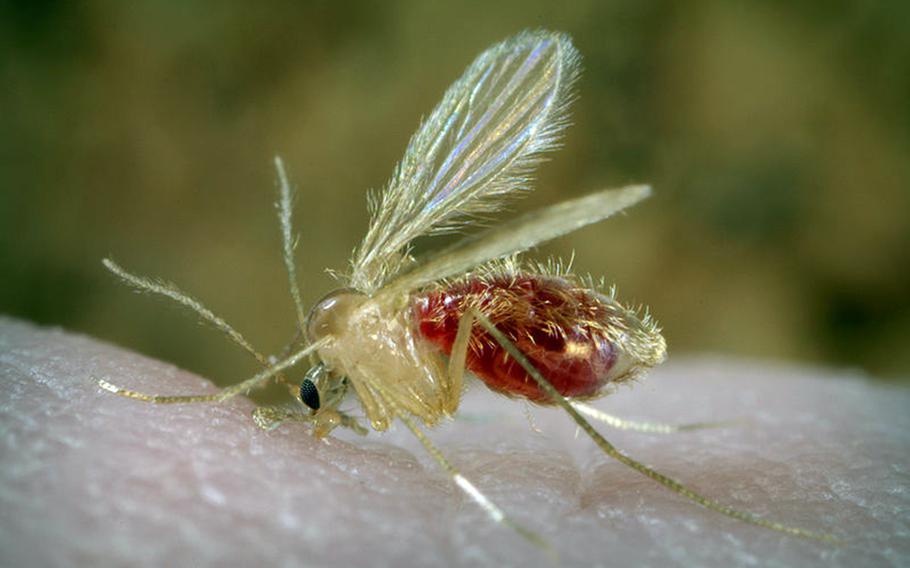
U.S. soldiers based in Honduras are investigating a local outbreak of a parasitic disease carried by the sand fly that has long plagued U.S. troops in Afghanistan and Iraq. (Frank Collins/Centers for Disease Control and Prevention)
Military personnel based in Central America are investigating an outbreak of a parasitic disease that has long plagued U.S. troops in Afghanistan and Iraq.
Joint Task Force-Bravo’s medical unit, based at Soto Cano Air Base, Honduras, recently conducted a medical field investigation into the outbreak of leishmaniasis in a nearby mountain community, the Army said Monday in a news release.
The parasite, called leishmania, is carried and transmitted by numerous species of sand fly, a blood-sucking pest found around the globe.
The investigation’s goal is to determine how and where the disease is spreading and then develop recommendations for stopping its sweep.
“Our job is to find out how local folks are contracting leishmaniasis,” U.S. Army Maj. Jorge Chavez, a public health nurse with JTF-Bravo, said in the news release. “How it is affecting them, how they are managing it locally through the Ministry of Health, how they are treating it, and whether or not there is a pervasive environmental threat to U.S. forces in the area.
Certain varieties of the disease can be fatal, he said.
“Leishmaniasis is one of the diseases of military interest and there are several variations of it,” Chavez said. “It can be debilitating; it can also have long-term effects.”
The parasite is spread by the bite of the female sand fly. They thrive in tropical and subtropical zones, as well as southern Europe. In the past decade, some cases have been reported in south Texas, likely from northward migration of tropical insects due to global climate change.
The Armed Forces Pest Management Board said in a 2015 report that disease, annoyance and distraction caused by the bites of sand flies can interfere with military operations.
“Indeed, sand flies historically have had, and continue to have, an impact on military and disaster relief operations, and refugee health support operations, underscoring the enduring requirement for sand fly surveillance and control,” the report said.
U.S. soldiers deployed to Afghanistan and Iraq for Operation Enduring Freedom and Operation Iraqi Freedom have been routinely exposed to sand flies, according to the Centers for Disease Control and Prevention.
The incubation period for the leishmania parasite can be long — up to many months — so an infected servicemember may be back home before undergoing symptoms, the most visible being large skin ulcers.
Cutaneous leishmaniasis is the most common form of the disease around the world, as its many nicknames attest: oriental sore, tropical sore, Aleppo boil, Delhi boil and desert boil.
Among the most serious variant is visceral leishmaniasis, a chronic systemic disease with symptoms of fever, progressive spleen and/or liver enlargement, weight loss, low red and white blood cell count and, if left untreated, possibly death.
Military personnel with potential cases of leishmaniasis have been referred to Walter Reed National Military Medical Center in Washington, D.C., since 1978, according to the CDC.
Walter Reed identified 12 cases of leishmaniasis in troops deployed for Operations Desert Storm and Shield during 1990-91, the CDC said.
From 2001 through 2016, 2,040 active-duty and Reserve servicemembers were diagnosed with leishmaniasis, according to a 2017 report by the Defense Health Agency. Almost 90 percent of the cases were associated with the deployments to the Middle East, primarily in Iraq.
The report concludes, however, that the actual number of servicemembers affected was likely much higher because milder cases typically go unreported or the diagnoses were made outside the Military Health System.
There is also often significant lag time between manifestation of leishmaniasis and its clinical diagnosis, a delay “ranging from weeks to months and sometimes more than a year,” the report said.
The Defense Department recommends that servicemembers at risk of being bitten by sand flies employ insecticide-treated uniforms and bed nets and apply insect repellent containing DEET.
olson.wyatt@stripes.com Twitter: @WyattWOlson